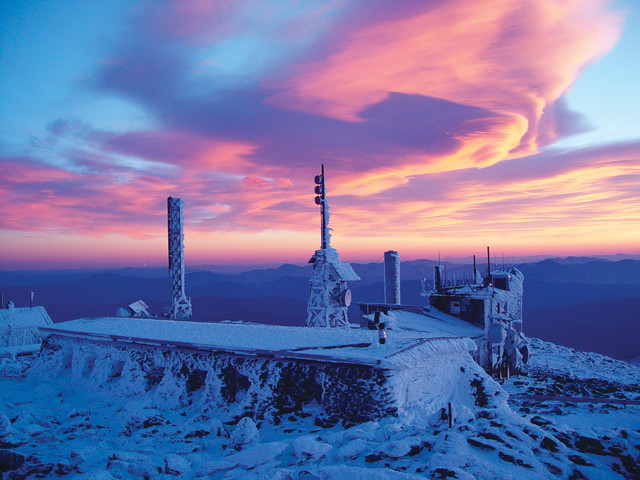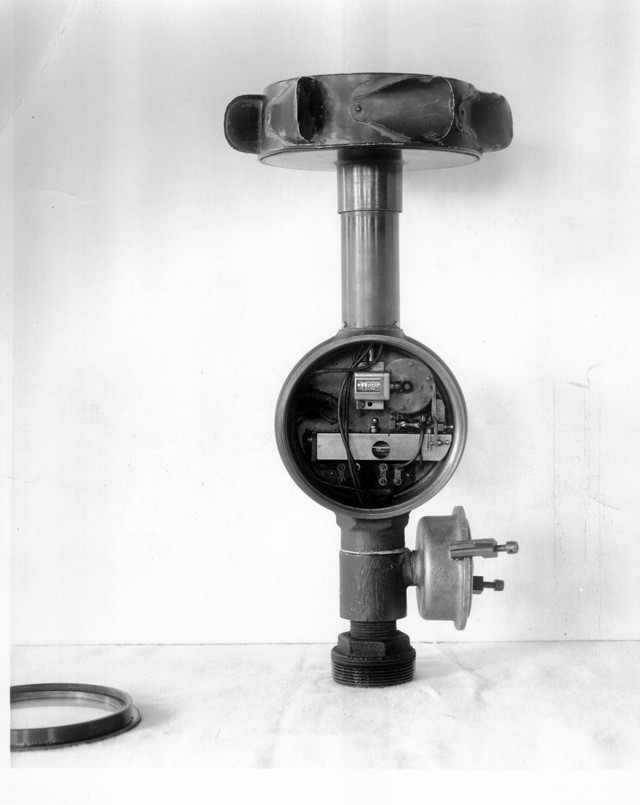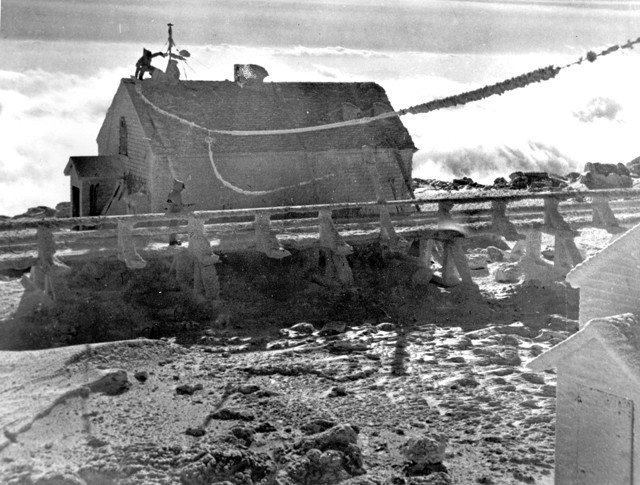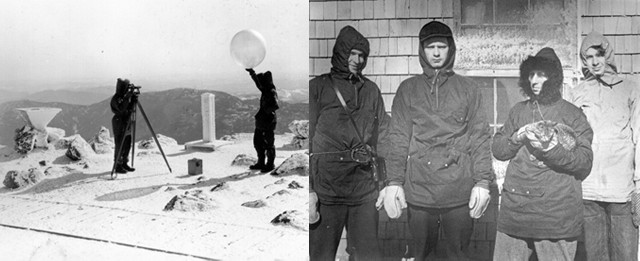
by Julia Rosen Monday, March 9, 2015

On a clear day, views from the Mount Washington Observatory extend to the Atlantic Ocean. Credit: Mount Washington Observatory.
When Jeff Masters was 5 years old, a brutish gust of wind knocked him flat. The incident transpired on top of New Hampshire’s Mount Washington, a place that has long fascinated Masters — now a meteorologist and the founder of the popular forecasting site Weather Underground.
“It was a beautiful summer day,” Masters recalls, when he and his family rode the old cog railway up from Bretton Woods to the highest peak in the state’s rugged White Mountains. “But we got to the top and it was like another world up there,” he says.
The winds probably blow stronger in his memory than they did in reality, Masters says. Still, he estimates gusts likely topped 80 kilometers per hour — strong enough to topple a small child, but not out of the ordinary for a spot that boasts “the worst weather in the world.”
Mount Washington rises barely 1,900 meters above sea level, but it has the demeanor of a towering Himalayan peak or a barren Arctic island. Thanks to a unique combination of latitude, geography and topography, conditions on the mountain are punishing and temperamental; Mount Washington registers hurricane-force winds about 110 days per year, according to the local avalanche center.
But the peak’s extreme weather isn’t just impressive — it’s record setting. For more than 60 years, the fastest wind speed ever measured on Earth’s surface was a gale that assaulted Mount Washington on April 12, 1934. Staff at the summit observatory clocked the gust at an astonishing 372 kilometers per hour.
Although Mount Washington recently lost its title to Barrow Island, Australia, during Typhoon Olivia in 1996, the mountain’s highest wind speed remains the fastest ever measured in the Northern Hemisphere, and the fastest ever captured by human observers.

McKenzie, Pagliuca and Stephenson (on the phone) eat a meal at the observatory. Credit: Mount Washington Observatory.

This heated anemometer measured the record-setting wind gust on April 12, 1934. Credit: Mount Washington Observatory.
Mount Washington crowns the Presidential Range of the White Mountains, basking in the prestigious company of Mount Eisenhower and Mount Jefferson, among others. In part, the peak’s harsh conditions stem from the fact that the mid-latitude jet stream often blows directly overhead, says Mary Stampone, New Hampshire’s state climatologist. Although the latitude of the jet stream can migrate, this torrent of high-level air that races around the globe from west to east frequently parks over New England.
“Friction with the ground slows things down,” Stampone says, so the higher you climb, the faster the wind blows. This is particularly true in winter, when cold temperatures — which make the air denser — compress the atmosphere and push the jet stream to lower altitudes.
Since Mount Washington is the tallest thing around, Stampone says, “there’s really nothing around it to break up any winds.” In fact, the surrounding mountains create a kind of funnel, forcing the air into a narrow channel, which causes it to accelerate before slamming into Mount Washington.
But the jet stream does more than provide a steady breeze — it escorts a procession of storms across the Northeast and over Mount Washington, accounting for its fast-changing weather. “Over the course of a day or two, you can have warmer wet weather, and then, as it moves on through, it can change to ice, then snow — all in a matter of hours,” Stampone says.

To clear the instruments of ice, observers had to climb on to the roof of the observatory, sometimes in harsh weather. Credit: Mount Washington Observatory.
Under special circumstances — like those that produced the record wind gust of 1934 — several different storm tracks can converge over New Hampshire, swirling into a massive maelstrom. These can include northerly storms, sometimes known as Alberta Clippers, that swoop down from Canada, as well as low-pressure systems from Colorado that gallop across the plains before veering to the northeast. Finally, Gulf storms can careen up the East Coast, bringing warm, moist air from the south.
These different systems, with different atmospheric pressures, create a potent combination, Stampone says. “The greater the change in pressure between the systems, the stronger the wind speeds are going to be.”
In the spring of 1934, the crew at the observatory included Alex McKenzie, a radio buff who helped establish a permanent presence on the summit in 1932; Salvan engineer from Naples, Italy, who had lost his job in the Depression and who had brought along two of his friends; and Wendell Stephenson, an engineering student who had just joined the team.
“It seems that their compensation at the time was about $5 per week, plus bunk and board,” says Peter Crane, the curator of the observatory’s library, and a former observer himself. They also enjoyed the company of a small cohort of resident housecats: Ammonuisance, Elmer, Manx, and Oompha and her five kittens.
But these men were hardly the first to experience and document Mount Washington’s heinous weather. Observers had been stationed there on and off since 1870, when the U.S. Signal Corps began making observations after the government launched the first national meteorological network. (It was approved by President Ulysses S. Grant and the task fell to the Department of War so itp-to-date information to the military.)
Stampone says Mount Washington was chosen because of its well-known weather extremes and convenient location. “It’s difficult, but it is accessible,” she says. However, due to budget cuts, the Signal Corps abann 1892, and the mountain saw only tourists until a team of civilians returned in 1932, founding the nonprofit Mount Washington Observatory, which staffs the summit even today. “The only gap that I am aware of was a very brief one — less than 24 hours — in February 2003,” says Crane, when a fire caused a temporary evacuation.
So observers were ready and waiting on April 10, 1934, although they had no idea record-setting winds were headed their way. The logbook reads, “A perfect day. Cloudless and calm.” Unbeknownst to them, however, two storms were about to descend on the mountain, one spiraling north from the Carolinas, the other howling in from the Great Lakes.
Conditions changed on April 11, as gray skies rolled in and the barometer began to drop. The winds, too, had begun to howl. According to an account written later by McKenzie, by 4 a.m. on April 12, the storm shrieked loudly enough to wake Stephenson, the night-shift observer. But when he checked the anemometer, it registered a suspiciously low 169 kilometers per hour — far weaker than the din implied.
So, Stephenson ventured out into the tempest — unroped — to hack away the rime ice that had built up around the weather mast, shielding the heated anemometer from the full force of the wind. (This, Stampone says, is why the observatory must be staffed.)
After he’d fixed the instrument, Stephenson and the rest of the observatory crew watched throughout the morning as the wind whipped faster and faster. According to McKenzie, a 354-kilometer-per-hour blast occurred around lunchtime, followed by the record 372-kilometer-per-hour gust at 1:21 p.m.
In McKenzie’s account, the staff felt both celebratory and pensive as the magnitude of the moment sunk in. Pagliuca mused in the logbook: “‘Will they believe it?’ was our first thought. I felt then the full responsibility of that startling measurement. Was my timing correct? Was the method OK? Was the calibration curve right? Was the stopwatch accurate?”

Weather observers have been stationed atop Mount Washington on and off since 1870 and permanently since 1932. A small cohort of resident housecats keeps them company. Credit: both: Mount Washington Observatory.
Mount Washington’s gust would eventually be believed, but not without proof. The U.S. Weather Bureau removed the observatory’s anemometer, tested its performance in a lab, and reviewed the observers’ measurement procedures. Finally, in July 1934, they validated the record.
The same process continues today, says Randy Cerveny, a meteorologist at Arizona State University. Cerveny oversees all global weather and climate extremes for the World Meteorological Organization.
“When we have a potentially new record that will exceed something that’s previously been set, we will call together a committee of meteorologists from around the world,” Cerveny says. With up to a dozen members, this group usually includes a local representative who can gain access to the measurement equipment, as well as experts in the specific type of weather phenomenon and in the instruments themselves.
“We try to make sure that, one, the instrument is still working and, two, that it was correctly calibrated,” he says. “We look over all the evidence for this new record and then make a determination as to whether it’s valid or not.”
In many cases, this process can take years. The Barrow Island gust, for example, didn’t become official until 2010, 14 years after it blew down Mount Washington’s record. The delay may have stemmed partly from the fact that even the Australian Bureau of Meteorology didn’t believe it at first. They assumed the instrument had malfunctioned, and without observers on site, they had no way to tell.
This highlights one of the main problems with measuring record wind speeds: often the instruments that might document new extremes don’t survive to tell the tale, Masters says. He says he’s certain that faster winds have brushed the surface of the Earth — we just can’t prove it.
But as technology improves, Cerveny thinks meteorologists will start to document faster and faster records as they put instruments in previously inaccessible places, “like in the middle of a tropical cyclone, or probably — eventually — inside a tornado,” Cerveny says.
Because of this, he says, despite its ornery weather and its historic run, “it’s unlikely that Mount Washington will reclaim the record.”
© 2008-2021. All rights reserved. Any copying, redistribution or retransmission of any of the contents of this service without the expressed written permission of the American Geosciences Institute is expressly prohibited. Click here for all copyright requests.